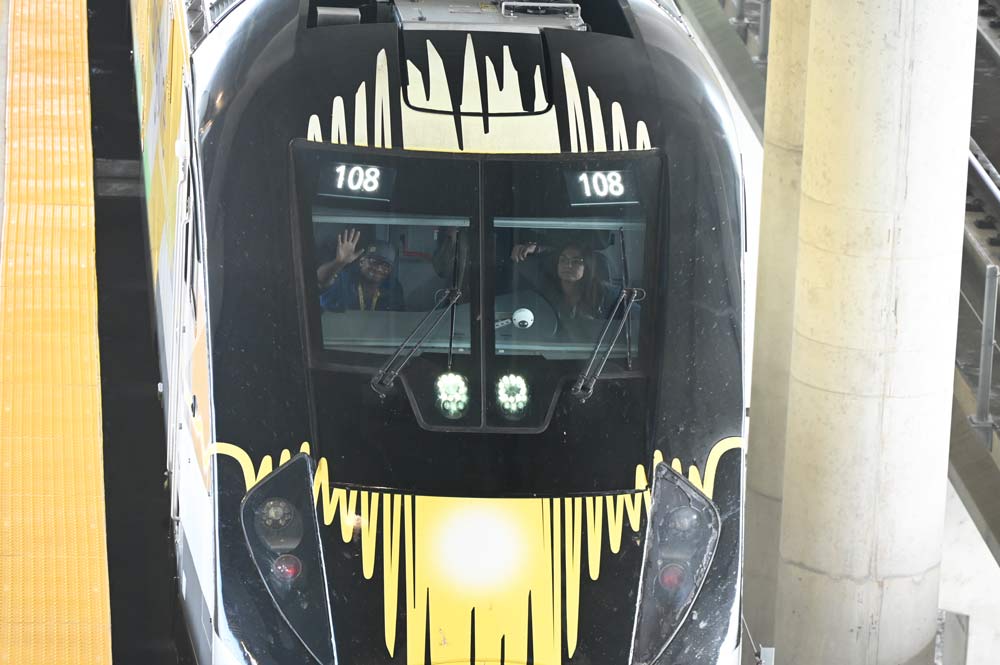
By Pierre Tristam
A couple of weekends ago Cheryl flew to Phoenix for our daughter’s baby shower and gender reveal, leaving me two days to fill with something other than the sand in nearing grandparenthood’s hourglass. Looking for a future-tense adventure, my son Luka and I decided to give Brightline’s new segment from Orlando to Miami a try, and you, reader, an account of the experience.
It was worth the miles on a pair of rides as smooth as the rails despite a few drawbacks: it could get unpleasantly noisy in there. Social media and the promiscuity of onanistic phones in every palm has taken the social out of public manners. Many of our travel mates took our compartment for an extension of their family dens, abandoning all decibel voice control, shoewear courtesy, AirPod etiquette. A Palm Beach Post columnist came up with a name for the types in the line’s early days: “Bratliners.” Floridians could use a refresher in personal boundaries, but maybe we shouldn’t yet blame intercity rail rookies. Brightline is new to everyone.
And boy, is it bright. They blind you with colors and courtesy and shiny floors and gimmicky visual puns and terrible textual ones (“How do locomotives hear? Through their engine ears.”) It’s the influence of Disney design contractors, who have been–might as well embrace the loony punning spirit–all aboard Brightline trains’ design since the company’s prehistoric days as All Aboard Florida. Bring shades.
It seems expensive: at $79 a ticket one way for us second-classers, $316 for two round-trips, it isn’t small change ($99 one way at peak hours.) But it’s not as much as you think. Not when you total up the true cost of driving a car. According to AAA, my medium-sized sedan costs me 69 cents a mile. For a round-trip to Miami, that’s $331, not counting tolls, Miami parking rates, wasted time, the risk and cost of a funeral or the days off my life resulting from any aggravating ride on I-4 or I-95. So driving to Miami only seems less expensive, and only if you drink Detroit’s Kool-Aid equating driving with freedom. (I can understand Americans thinking of their wheels as their own daily flag-raising on Mt. Suribachi, but look at what cost.)

Besides, Luka and I love trains. We ride SunRail for kicks, dreaming of Neverland when commuter and bullet trains will grid Florida and abate its tyranny of infernal Interstates and steel swamps posing as roads. Assuming the Atlantic doesn’t get there first, I still see a SunRail station in Bunnell sometime in the early part of the 22nd century, and a Brightline station in Jacksonville in the middle of the 23rd, as we tend to be roughly 200 years behind the civilized world in public transportation.
For now, we have just these spikes of rail lines, making not as much sense by themselves as they will, once a full network is built out. But they have their advantages even now, as this trip proved. The disadvantages, and there are a few, are fixable, not fatal. Fixing them is also essential if this is going to work. That goes for the way this trip began: by car, on I-95 and I-4, reducing my lifespan by at least a day and a half.
The Journey to the Journey
I left Palm Coast before dawn Saturday, picked up Luka at his UCF dorm in Downtown Orlando, and got to the airport at 8:30. Terminal C’s parking lot, the one attached to the Brightline station, was full. We hunted for a parking spot for nearly half an hour before finding a clump of grass in “South Park Place,” an economy lot a shuttle’s journey and another tram ride to Terminal C before we could finally reach the station around 9:30: not the easiest experience of parking and riding. Travelers hopping from plane to train, like Tracy, one of the delights we met on the train, will have it easier.
Terminal C–for Cathedral–is a $2.8 billion ablution of unstained glass and stratospheric ceilings that reminds me of the Oculus at Ground Zero in Manhattan, with more windows and fewer people. The terminal seems constantly to be inviting you to ascend, as you must to reach the Brightline zone. Then the transfiguration. Ceilings drop, windows rarefy, lights dim as the station’s layered domes in heaven redirect your sights inward, through a rectangular tunnel and into an automated ticketing and security area on floors shiny and spotless as a medical research lab’s.
Crossing into the passenger-only zone was quick, easy, courteous, especially on the way south. (There was an unnecessary re-check of our tickets on the way north.) We’d booked tickets online. No check-in necessary, just a quick, unsupervised scan of the QR code at the tunnel’s entrance, then the security check. You put your bigger bags on the scanner roll but without the indignities of taking off shoes and belts, no disgorging of pockets, no standing arms up for a body scanner to pick off the metal in your pants’ zipper. An attendant stands by to assist. Another watches the monitors. Travelers or their luggage are rarely poked. Obviously, there’s not as much concern about suicide bombers on trains.
I’d insisted to Luka that we should get there two hours ahead of time to explore the station. That proved to be unnecessary. The Brightline portion is a glamorized, hierarchic waiting room with a bar. First-class passengers, called “Premium,” are in a gated lounge of more egocentric furniture (more space for gluteal flab, less chance to graze another human’s elbow), free drinks and snacks by themselves, with just enough voyeurism allowed to make the rest of us envious and maybe shell out nearly double the fare next time.
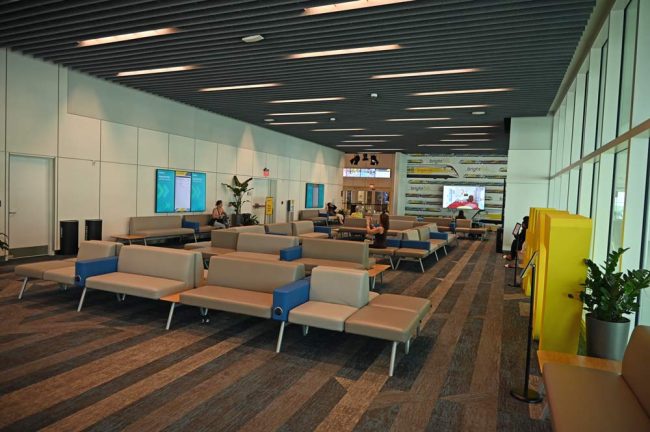
Second-classers, patronizingly called “Smart,” are assigned a workmanlike waiting room of tightly packed armless chairs as if picked at Ikea for a student lounge. USB ports and three oversize screens go for amenities, plus a visual pun that now signs every station: a brash, needlessly space-hogging sculpture of the hash-tagged local area code in bright yellow (#407). Likely the work of an intern just graduated from RISD, it has no thematic or artistic connection to its surroundings, and doesn’t mean what it used to now that area codes, like jobs and property tax brackets, are so portable. Brightline is still groping for an identity.
Solari Memories
You know the 21st century has moved on when you realize that not a single newspaper or magazine is on sale. The only kiosk is a modest display of cheap-looking but expensive gifty knacks for guilty adulterers or absent parents. There’s also a greenish “marketplace” for snacks and a spare choice of calorific drinks, but without an attendant. It’s only QR-accessible. I don’t know why that would be necessary in a passenger-only zone. A traveler was having a difficult time convincing the scanner he was legit. I didn’t bother.
We took a seat at the white-topped bar where we tried the coffee (good), a couple of egg sandwiches (passable) and a pineapple smoothie for Luka: $36, not including tip, all served by a bartender who acted as if she couldn’t be happier anywhere else. It was 9:30 Saturday morning. Someone, maybe a jetlagged Britisher on a red eye cure, was downing Beefeater. Someone else in the sitting area behind us was on her speaker phone–first of many loudmouths–describing her Brightline experience so far. She liked it. She made it a smidge less likable for us.
As we were sitting there among the other few who were too early for their ride, I heard one of the enchanting sounds of my childhood: the inimitable clicketyflap of a Solari Board magically conjuring its announcements. I would be hypnotized by the one at Beirut International Airport in the early 70s, when the board’s riffles through Athens and Paris and London and Delhi would be as far as my travels could go back then, as we were always dropping off or picking up someone. I was never the traveler.
Brightline had installed a pair of Solaris (named for the Italian company as old as the Enlightenment that designed the first boards), just two lines each, high above the bar, a more elegant hat tip to the previous century than, say, a rack of pulp novels with erogenous covers. The RISD intern was redeemed. But there wasn’t enough to justify them as travel-schedule boards, so they flipped through those puns like the ear engine above, or Brightline marketing in the Airstrip One style (“Faster. Greener. Easier.”) and the unavoidable tributes to trivia: “2 million spikes and bolts to build new rail.” No running count, as yet, of the number of people killed on those rails, a count that could warrant its own busy boards.
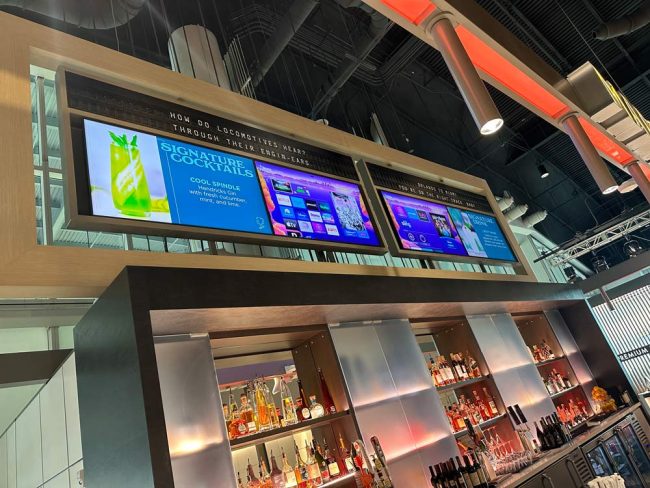
The waiting room was almost empty when we arrived. It was full by the time boarding was near. Too full. This was for a four-car train with capacity for 240 passengers. Brightline has plans for seven-car trains carrying 356 passengers. The proles’ waiting room does not look roomy enough for that. The adjoining space behind the bar is also a lounge, but when we tried to sit there after breakfast, the kiosk attendant was quick to stop us: “Only if you’re going to order some food.” Or if you’re Premium. The edict didn’t last: as boarding approached, there simply was no other place for people to sit, so even the third estate was allowed there.
Luka and I were perched on a long, thin, plug-in table, imprisoned by another loudmouth who started sweetly on a video call with googly sounds to his infant child, then graduated to perfunctory affections with the child’s mother before telling her his charge was diminishing. He just wanted her off the phone so he could get louder with his golf buddy, all on speaker phone, oblivious to his crowded surroundings.
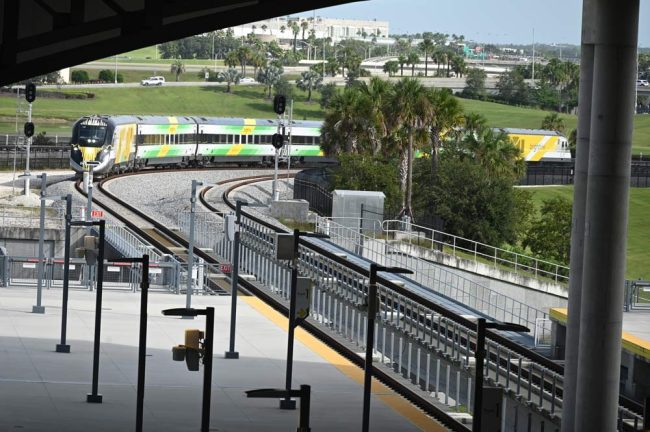
Then, the apparition. A Robert Penn Warren moment, like the opening bars of a live concert: “And all at once you feel like crying.” The first of two Brightline trains, a reptilian black and yellow locomotive, pulled a green and yellow tube around a bend before so quietly gliding into the station, one of its conductors happily waving at the gawking photographer far above (me). For some reason it struck me, happily, that the other person at the controls was a woman. An orange and yellow train soon followed, both disappearing beneath us to disgorge their passengers before we were called down. This was one of the pleasures of the trip: between the boarding call and the train leaving the station was a matter of minutes. I’ve had to wait longer for the #7 train at Times Square to start for Flushing. So it would be at every station hence: you barely get a couple of minutes to get off or on.
126 mph Along Old Dixie Highway
It wasn’t long after that that we were clocking in at 126 mph, according to my tracking app, though the empty stretch between Orlando and the ocean would be the only place we would go that fast. The rest of the way was between 70 and 90, and more often closer to 70 than 90, significantly slower in the concrete jungle of South Florida. But there’s great pleasure in seeing yourself aboard a train going faster than the cars on the adjoining road, like riding an open express lane next to clogged traffic.
The windows are big rectangles easy on sightseeing, with shades in case of direct sunlight. The way south, under a torrid sun, got a bit warm despite the AC. I was glad to have my sweater for the cloudier, cooler return trip. The alley between the seats is carpeted a deep blue and roomy enough not to keep someone from passing the snack-and-drink tray, or a clump of people chatting upright. The aisle side of each seat is equipped with a handy metal grab-bar, making ambling along the aisle steadier.
The unisex bathrooms are too few but roomy–none of that airplane straitjacket feel–all contactless down to waving your hand over a green LED to flush, with a cushy bench along a window outside the door in case there’s a wait. There usually is. (The bathrooms in the stations are not unisex, so no luck getting around Gilead’s genital policing. But they are also roomy, with top-to-bottom privacy panels and cubicles of faux wood to prevent either peeping or policing, including between the men’s urinals, a necessary improvement on public bathrooms that too often seem like ashrams for pervs.)
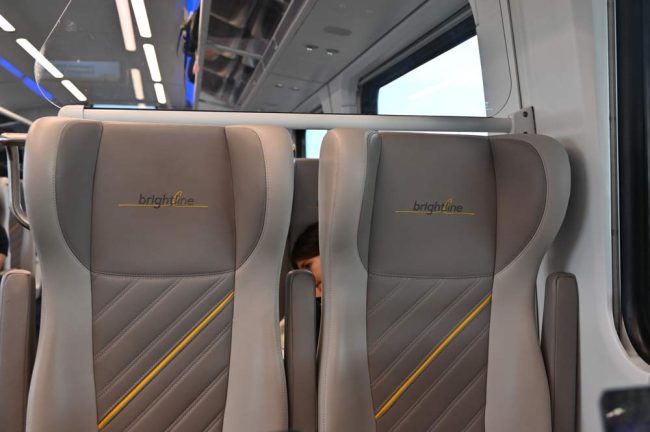
The seats, 19 inches wide (21 in the aristocratic car), two on each side, are leather, not too cushy but not uncomfortable even after three hours. There’s room for the shoulders, the legs, the head, the soul. Each pair of seats have two pairs of WiFi and power hookup, one below the armrest, one below the seats in front of you. The WiFi could occasionally be spotty, especially in that old Florida stretch of scrub and pines between Orlando and the ocean.
Even better. If America has become so neurotically arid, so diminished by the self-stimulant of hypertensed grievances, it’s at least in part because we don’t spend enough time gazing mindlessly out a train window at the poetry of trapezing utility poles or the still lives of railroad crossings, at the insurgence of green defying the densest sprawls or the split-second Chekhovian sight of a lady with a dog leashed to the remains of her days: a train moves us through lives more moving than we know, starting with our own.
I did not gaze enough, as this neurotic account suggests, my laptop open most of the time. A big tray allows for a laptop and a drink, though I found that the elevation and distance from the seat made typing hour after hour difficult. I am typing these lines with the laptop on top of my lap, as I suppose God intended. It’s not a problem, since the ride is smooth enough that I only occasionally have to keep the machine from sliding off. Luka has been happy to use the tray to watch his “Lupin” most of the way, with his earpods in, thank you very much. There’s also a mini-tray for more focused drinkers.
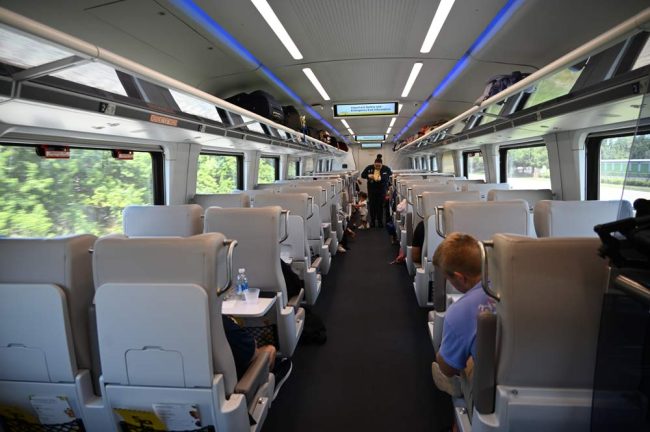
The train itself is remarkably quiet, the rhythmic rumble of wheels on steel or the train horn muffled almost as if you were hearing a freight train pass through Bunnell while sleeping a mile or two away. It’s too quiet, really, because the compartment ends up feeling like a library room where you can hear most of the conversations up and down the aisle.
So we hear those who think they’re the most important person in the room, those who think their Krakatoan laugh is as delightful to the rest of us as it is to a seat mate, those who think we should have to hear every inflection of both sides of a video conversation. Children’s iPads unattached to earphones or children’s vocal cords training for a future of Krakatoan bellows were the volume-added pains. Still: nothing that couldn’t be solved with a pair of noise-cancellers. I happened to have left mine in the car, thinking I was going on a golden-silent TGV.
Canterbury Tales on Brightline
Most seats are paired in one direction. Each car has a few quads of seats that face each other, with a thin table in between. We sat at one of those on the way down, enabling us to meet two pairs of companions at different parts of the trip and learning more from them about Brightline’s benefits.
Tracy from Westchester, N.Y., had flown in to meet her friend Jessica, Jessica’s teenage daughter and a rather large group of friends for a trip from Boca Raton to Universal’s Halloween Horror Nights, because it isn’t enough of a fright just to live in Florida. “You can’t have a cocktail driving,” Jessica said as she and Tracy ordered their bloody marys. They’d get back home as relaxed as when they’d left, chipper, maybe a little buzzed but safe: of course it’s worth the price. Never a need to rent a car, with Uber filling in where necessary.
Onboard “offerings” are limited to a sampling of convenience store basics at twice or three times the price–Pringles, M&M’s, peanuts, $10 cups of ordinary wines, $12 cocktails, three types of beer, two of which have no business calling themselves beer. A few salads and sandwiches looked appetizing ($12 and up) though I inexplicably neglected to sample them.
We were approaching Boca Raton, where Tracy and Jessica left us and were replaced by Pat Williams, a publicist, and Janeen Mason, a curator–a pair of Americans who traveled with the elegance of characters from The Magic Mountain: they’d seen their share of the world, too, and knew how to have a conversation with each other without being heard. But we wanted to hear them.
The Lost Arts
After introductions we talked about the arts, about train travel in Europe, about Janeen’s Lighthouse Art Center in Tequesta and their planned loop around Miami to catch, as I recall, a gallery show or two, and we talked about Israel, because it happened to be October 7 and news of the Hamas atrocities was beginning to trickle in: the conversation was too engrossing to keep taking notes, which is a shame because the details now escape me, like those views out the window.
That’s another thing we’ve lost, it seems to me, to our incarceration in cars: the felicity of unexpected encounters and conversations with people we’d never otherwise meet, with backgrounds richer than our routine circles allow anymore. Cars’ autonomy, that alleged freedom, also cuts us off from these encounters, fracturing us that much more. Car-centric societies are more polarized societies. Janeen and Pat were headed for galleries, but the journey there for us was its own gallery in the form of conversation, that so-democratic art that could make masters of us all if we only tried. Speaking with them made me realize how much my conversational skills had atrophied. It was as if I was speaking in crayon. Every once in a while we’d be drowned out by the video jingles from a couple of seats back, or the Italian mother taking her son’s iPad away for his rudeness.
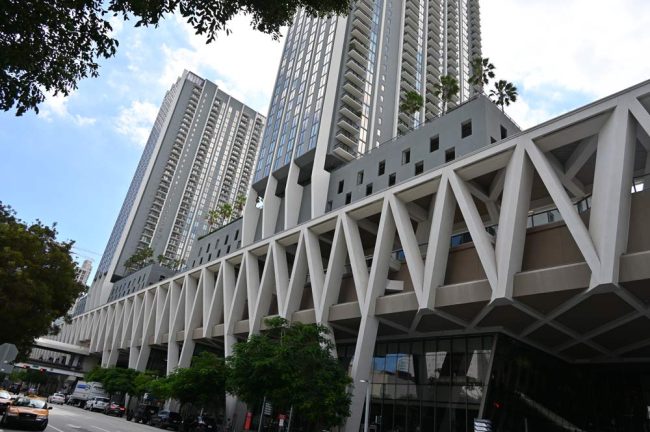
Janeen had been traveling Brightline in South Florida for over a year, Pat a bit less. They’d never seen it as crowded, as noisy, as progressively dirtier, though my male eyes had trouble noticing the dirt. We were just about 100 percent full, especially after stopping in Boca Raton. “This is not the luxury experience we’ve had in the past,” one of them said. Weekdays, they’d seen it mostly empty. Maybe Brightline was beginning to live up to its promise.
So maybe this is where you can jump off for the next few paragraphs and get back on toward the end, if you’re waiting for the big reveal, since this is the more pedestrian part where I briefly tell Brightline’s backstory, which may be as dull to most of you as the South Florida sprawls we were crossing.
Brightline in the Fine Print
Brightline was born in 2012 as All Aboard Florida, a Coral Gables-based company affiliated with Florida East Coast Industries, itself an affiliate of the Florida East Coast Railway (a company briefly owned by Japanese conglomerate SoftBank Group in 2017, then by Mexican company Grupo México Transportes since). It started as a $1 billion plan to use FEC tracks to Cocoa Beach and build 40 miles of track to Orlando, with 12 to 14 trains a day between Miami and Orlando beginning in 2014, with projected expansions to Jacksonville and Tampa. The idea was to capture some of the 50 million people who travel between Miami and Orlando every year, by car or air.
Opposition started quickly, but on the whole it was limited until trains started running. Volusia County officials worried that the line would compete with SunRail even when they had no idea whether SunRail would ever reach Daytona Beach, as it unfortunately has not. (“I think we have to be particularly aggressive in protecting our turf,” Councilwoman Pat Northey told the News-Journal at the time.) At a Federal Railroad Administration forum the next year the public worried about homes “being rattled to death” and deafening residents along the tracks. Loxahatchee River boaters worried about drawbridge bottlenecks as the plan upped service to 32 a day. Martin and Indian River counties sued the federal Department of Transportation in 2015 to slow or stop the project. The suits were dismissed two years later, only for Indian River and a citizens group to file suit again in 2018 on safety claims. The sides settle in 2021 in exchange for $31.6 million in safety improvements at 32 rail crossings in the county.
The company changed its name to Brightline in 2015 to reflect its optimism about future train travel. There was a brief deal that would have rebranded the lines to Virgin Trains USA but Brightline pulled out and Virgin sued for $251 million.
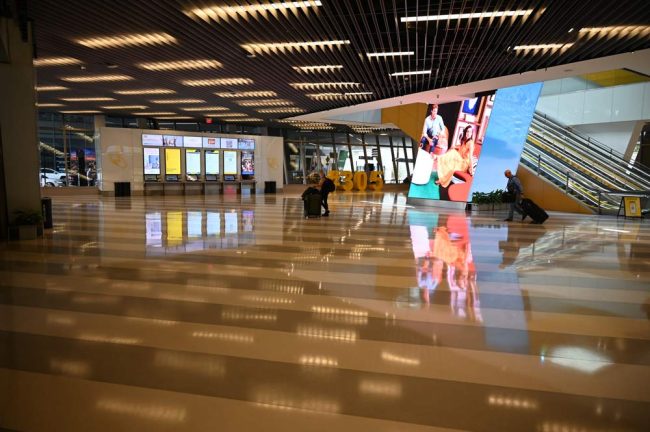
The company in 2015 promised free WiFi and power outlets at every seat, free bike and luggage storage in every car. The WiFi and power survived, but in September Brightline, in one of several unwise retreats that made early amenities sound like deceptive lures, forbade bikes. You also now have to pay for luggage: $10 for a carry-on larger than a personal bag, $25 for a checked bag, $75 for a third bag, more if the bags are heavier than 50 pounds. For pets, it’s $25 per. Paying for luggage on a train, no matter how heavy, makes no sense. All the free rides Brightline used to provide, like free shuttles to Miami Beach, free shuttles within a three-mile radius of the Miami station, are gone.
Minor issues, compared to how Brightline trains started killing people. On Jan. 16, 2018, the first Brightline train with passengers started service between West Palm Beach and Fort Lauderdale. The next day, Jeffrey King, a 51-year-old cyclist, became the first person to be struck and killed when he pedaled around the gates in Boynton Beach. Service to Miami began that May. By June, four people had been killed, 11 before Christmas. As of late September, 99 people had been killed, a majority of them suicides.
You can’t blame the Grand Canyon for jumpers and careless hikers. If at some point personal responsibility and the will to die take over, you can blame the Park Service for not minimizing the opportunities to jump, or Brightline for not investing more heavily in safety measures. The Associated Press reports that Brightline has the highest death rate of any line in the country: one death for every 32,000 miles of travel, which has worked out to about a death a month before the Orlando extension. Only last year Brightline announced a joint plan with the Florida Department of Transportation to spend $45 million to eliminate train-crossing deaths.
Self-Funding Selfies
The company likes to say–with the ideological arrogance of private-sector sneers at government–that it is entirely privately funded. Well, the dollars it spends are private. But to say that the funding does not benefit from public subsidies is not accurate. The company has benefited from low-interest federal loans, tax-exempt bonds and refinancing whose generous terms are an indirect form of public subsidy, the same way that low-interest student loans or the mortgage-interest deduction are. And of course its stations benefit from immense public investments in what makes intermodal transportation–the combination of different types of transportation options, such as cars, plans and trains–possible. Brightline could not exist without public sector investment in infrastructure.
In 2020 Brightline reported to its investors that it had fewer than 1 million passengers. It had banked on 2 million. It reported 2019 revenue of $22 million, less than a fifth of its projection.
Its 2022 report to investors read: “For the month ended December 31, 2022, we carried 183,920 passengers and generated total revenue of $5.1 million. Ticket revenue in December 2022 increased 205% compared to December 2021 to $3.7 million, with ridership up 87% and average fares 63% higher compared to the prior period.” It also reported ridership increasing from 159,000 in 2021 to 1.23 million in 2022. “The strong year over year increase in revenue,” the company claimed, “reflects continued adoption of our service and the opening of our two new stations in late December.”
Not quite. The strong year-over-year increase reflects the fact that Brigthline was shut down for 11 of the 12 months in 2021 due to Covid (trains stopped from March 25, 2020 until Nov. 7, 2021), and had just reopened to leery travelers that December. But Acela, the first high-speed rail service in the country, serving Washington, New York and Boston, started anemically in 2000, and to a lot of skepticism. Ridership grew to 3.4 million by 2018 before taking a hit with Covid, falling to 2.1 million last year. Proportionately, Brightline seems to be ahead for such a young line in a less dense corridor.
Continental Europeans, the Japanese, even the Chinese do public transportation way better than we do–logically, technologically, environmentally, economically, you name it. But Brightline is trying, and in most ways it’s succeeding.
Miami Beach Layover
We arrived in Miami in the promised three and a half hours: not enough time to get tired of the trip despite the noise. There was the hash-tagged 305 sculpture in the exoskeletal station, its one-time red “V” along its concrete trusses, in homage of Virgin, now back to plain white, its floors as glossy as in Orlando, but also oddly empty, for a train station. The station lives in bursts, despite a few attached businesses.
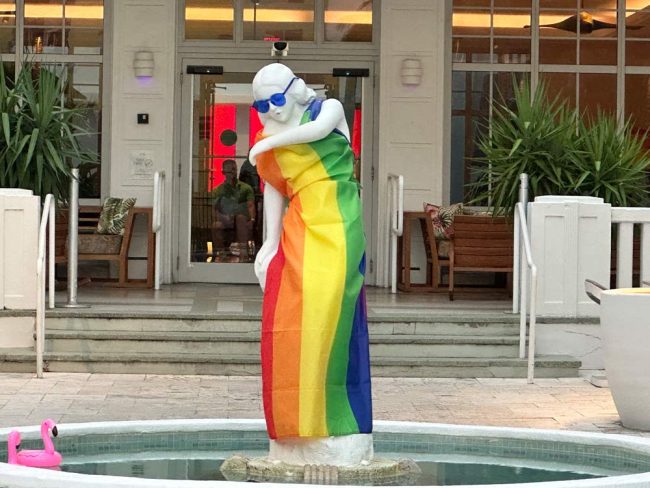
It connects to Metromover, the free loop, and to Metrorail, plus buses at street level and the lurking armadas of Lyfts and Ubers anywhere you swipe. We made the mistake of Ubering to Miami Beach, where we were spending the night, when we could have made the trip for all of $2.50 each, as we would the next day.
The overnight in Miami Beach, that ecstasy of architecture and walkable neighborhoods, is another story. The less eventful way back beckoned the next day, as did, 38 minutes after we were back in Orlando, the text from Cheryl with the big reveal from Phoenix: Sadie and Rigo are having a boy. His name is Felix. He’ll be born the first week of January, apparently on my father Fouad’s birthday, because that’s when Sadie wants it timed.
Back at the South Park Place parking lot, Luka and I took a little detour by the fence alongside one of the runways to watch a couple of dozen planes take off and land, the way my father used to take me on a terminal balcony at Beirut International. We didn’t want to desist just yet from our intermodal romance, and we had big news to process. I think it was along that fence, amid the reifying smell of jet fuel and the unusually frequent and kind waves from pilots in their passing cockpits, who must have gotten wind of the reveal, that Luka became an uncle, and I became a grandpa.
![]()
Pierre Tristam is the editor of FlaglerLive.
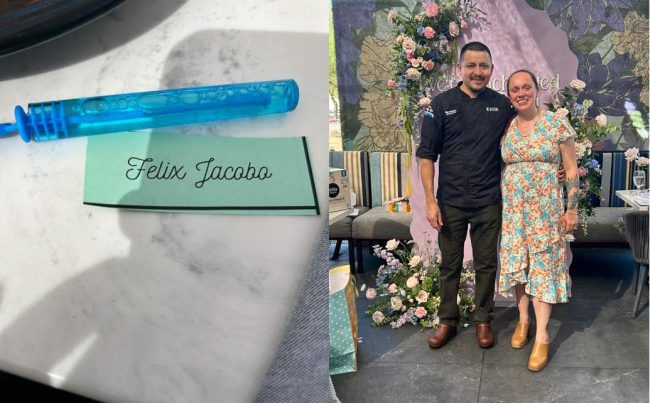




























Steve says
I live by Sunrail in Seminole County and use it frequently. Very convenient. Really like the expansion they have planned and will take the same trip soon. Glad you enjoyed the ride and weekend with your Son
John F Pollinger says
A wonderfully written article. May I add congratulations to the entire family on the upcoming new addition of a baby boy, Felix.
Mothersworry says
I’ve a few questions.How much Federal Funding is involved? How long will it be involved, when is the end date of that funding? When and if the Federal money or any funding source goes away who is on the hook to keep this running?
Remember all the freight railroads got out of the passenger business as it was not profitable and Amtrak was formed and is now federally funded.
Sam Gall says
Who is on the hook when our roads crumble and fall apart? Or our bridges? The government federal and state! At least everyone can use rail not just car owners like highways.
bob says
BINGO !
Jess says
As a local taxpayer I take issue with the fact this train is mostly for tourists.
No local is going to pay $200 round trip from Orlando to Miami, especially when it’s only 20-30 min faster than driving. In Europe you can take a train from Paris to London for less. Great concept but it’ll be a bike trail when it fails.
Mark says
“…from low-interest federal loans, tax-exempt bonds and refinancing whose generous terms are an indirect form of public subsidy, the same way that low-interest student loans or the mortgage-interest deduction are.” Not direct Federal Funding.
Mothersworry says
Based on info and belief also experience, this venture will not pay for itself. Sure, they have figures but… This equipment in time will break down after any warranty has expired and the repairs are real expensive. Eventually they will go to the Feds for a subsidy to offset the cost of operation. In some states an assessment is levied on cities and towns that derive any benefit from the rail line, stuff like a station or whatever that is located in a city.
Not saying this will happen but it is something to keep watch on. Just something I read a few years ago, there is no rail passenger line in the world that makes a profit.
Bob Pickering says
Good Morning! The Brightline Business Model is not like regular passenger trains. It should also be noted without Federal Funding Airports, Airlines would shut, ports would stop operations and highways would fall apart. Every aspect of transport in the United States gets some sort of federal funding including the profitable freight railroads (and oil companies GET a lot of federal funding, that is another story) The Brightline Business Model takes into account income not just from fares but also real estate, tenants and other investments and the right of way was already owned by the FEC intially giving them a running start. Brightline like many businesses does take advantage of some federal loans and grants but so do airlines. Many rural airport servces would cease without it. The rail system is privately owned. It’s not “public transport” like Sunrail. So far Brightline has done well due to demand extra trains have been added between West Palm Beach and Miami. New stations also built. There are no assurances in anything, remember some great companies have gone bankrupt, Eastern Airlines for one. But for now and for the foreseable future Brightline appears to be doing well they are also a partner in the “Sunshine Corridor” project that would bring much needed alternative transportation to International Drive, the attractions and to Tampa. Further the station will be a gatway for Sunrail to reach the airport.
Mothersworry says
With all due respect. Eastern Airlines did not go bankrupt, it was destroyed. That horror show was orchestrated by a fellow named Fred Lorenzo from Texas who bought Eastern Airline and proceeded to strip and sell off everything of value at cut rate prices to another airline named Continental that Lorenzo owned. At the same time he was wrecking Eastern he cut the employee’s pay a strike ensued. Bottom line at the end, Eastern was gone, thousands of folks lost their jobs and at the very end, years later Lorenzo was banned from the airline industry for life for his actions by the court. Actually, the movie Wall Street was loosely based on the Eastern fiasco.
Becky says
Been there and we loved it, our grandson loved the trip, what kid wouldn’t enjoy a train ride. My take looking into the future, talking to a Brightline rep, once Brightline starts adding more stops like Tampa and along the Treasure Coast ( Stuart, Vero Beach, and Fort Pierce) and who knows where else, I see these trips turning into the GreyHound Bus ride, where you stop at every town along the route to drop off or pick up passengers LOL, hence the new delays in trip times that very well could impact ones trip, which could impact the “train ride fad”, as if its not getting you there FAST, why pay to ride it. . .. Regarding your comment “Brightline for not investing more heavily in safety measures.”. None of the deaths have been found to be Brightline’s fault,” citing suicides, drivers going around crossing gates and pedestrians running across tracks.”. No amount of security or measures will stop anyone for attempting suicide by walking in front of a train or not obeying the crossing gates or attempting to beat a train approaching on the tracks. I’ve seen impatient people in cars and trucks at railroad crossings, the gates are down, flashing lights and they just drive around the gates, EGO in hand mixed with lots of stupidity, you can’t fix stupid.. Glad you had a fun exploratory time.
Skibum says
Thanks for the interesting review, as I have been considering taking a ride on the new Brightline train to experience it. I share your frustration and disappointment regarding the inconsiderate cell phone habits that so many people seem to have in today’s world. It would be so nice if people would be more courteous when talking on their phones in the presence of other people. I tend to get really irritated at those who always want to put their phone calls on speaker phone with the volume up loud as if everyone within earshot wants to participate in their not so private conversation, and I usually end up staring at a nearby clueless individual doing that until they get the message and walk away. When did people lose their manners as well as the ability to have discreet conversations without interfering with others?
William Moya says
👍👍, well done Pierre.
Mark says
” It’s the influence of Disney design contractors, who have been–might as well embrace the loony punning spirit–all aboard Brightline trains’ design since the company’s prehistoric days as All Aboard Florida. Bring shades.”
Good article and glad you made the trip but the Disney comment surprised me. I’ve never heard of their involvement since the designs of Brightline were the brainchild of Siemens and the Rockwell Group utilizing the Charger locomotive that was already in production. One thing Palm Coast should really do with their “Imagine 2050” plan is to be setting aside at least 5 acres for a possible station, Jacksonville is in Brightlines proposals for future expansion., though I won’t hold my breath for Palm Coast to do the right thing.
Bob Pickering says
I had a few behind the scenes tours on Brightline since the concept started. Brightline actually hired people from Disney to help design the stations as well as help with publicity. Everyone we encountered appeared to be highly motivated.
Mark says
Thanks Bob for filling in about the stations and publicity part. Cool you were able to get a behind the scenes tour, I have been able to follow from the start through Trains Magazine and it’s website along with some other publications. As the time comes for more train sets in the future keep an eye out on the Rochelle Train Cam, have seen a few come through there on their way here from California.
Laurel says
As a kid, I used to travel from Ft. Lauderdale to Manhattan fairly often with my grandmother as she purchased clothing for her shop. I love trains! We would get sleep compartments, and lay there while the rhythmic sounds lulled us to sleep. I enjoyed staring out the windows for hours watching the country go by. Aside from Grand Central Station in all its glory, Deland, by far, had the cutest station. We would eat on linen table clothes in the dining car, and eat chips, drink sodas and play cards in the club car.
Things change. The club car is now the smoking car, which is one solid cloud. The trains are not as clean. People today have no sense of manners, or respect for personal space. I don’t think I would enjoy the trip so much with noisy blabbermouths all around me, but that’s how people are now. Self involved.
One of the downsides of this area is one has to travel quite a distance to get to transportation, so the car is still important. We used to literally live less than two miles from Palm Beach International Airport. Nothing stops along here, and nothing is planned. It doesn’t make much sense to me to travel all the way to crazy Orlando, to catch a train, then do the reverse. Round trip to Orlando from here is equivalent to driving to south Florida. Well, we were trying to get away from the crowds!
Bob Pickering says
Things have changed again. Smoking is banned on Amtrak now, they ask for folks to smoke at the station stops which the ones where crew take place allow time to do that. Amtrak still needs help, better funding but the smoke cloud on the trains is a thing of the past.
Laurel says
Bob P.: Good (smoke ban)! Obviously, it’s been awhile. We are very interested in other train rides such as throughout the west, and Canada. I do miss trains.
Sherry says
Great story Pierre. . . and, congratulations on the new addition to the family. It wasn’t so very long ago that you published one of my favorite all time photos= Luka riding on your shoulders. Train travel. . . one of the best parts of a trip to Europe.
Regarding “rude” cell phone users. . . I noticed the same thing in Florida supermarkets. . . so annoying. I have actually semi- joined in on a couple of conversations in order to help people realize that their conversations weren’t private. Normally just giving out recipes, etc. On one occasion even suggesting that a woman advise her friend to seek counseling. . . after a very loud (on speaker), extended conversation (while blocking the aisle in Target) that should have been kept quite private. The woman then her turned off the speaker and whispered to her friend that some “nosey” people were actually listening to their conversation. Amazing! Mission accomplished, though.
Where have all the good manners gone?
Laurel says
Sherry: No more manners, all gone. When we first came to Palm Coast, people would smile at us, wave at us or say “hi” just passing in the parking lot. People we didn’t know. Now, people look though us, over us and around us. The friendly atmosphere has been completely rewritten by people who have no emotional investment in the area.
Maybe everywhere. We are in a period of “God bless me and screw everyone else.” We are on the ICW, and every day, I see people who do not slow down for fishermen, kyackers, river workers or boats in tow. Even when they must be flagged to slow down, because it doesn’t occur to them, they don’t slow down and look at the people in need of less wake like they are from Mars. No thought. Oh, and no one wants to hear some pickle-head’s music blaring out of their boat or car.
No, we’re not interested in your phone conversations. Take it off speaker if you’re in public.
I can’t tell you the number of times I’ve pushed some dead head’s shopping cart out of the way. It’s just the way it is now. Obviously, people are not being taught about manners anymore.
Sherry says
Good Morning Dear Laurel,
As usual, your observations are right on!
Being raised in rural Duval county in the 60’s meant that our culture centered around the kindness and pride of “Southern Hospitality and Manners”.
Although my family was financially poor. . . dependent on my grandparents’ garden and seafood business. . . we were rich in family love. At a very young age we were not just taught, but “required” to “mind your manners”. That mandate not only meant “respecting your elders” but, extended to ALL areas of respecting and being kind to others. Which, thankfully, over the years, grew into the self confidence to respect myself. At that time, our teachers in school certainly reinforced those basic “good citizen” lessons.
I agree with you that fundamentally those kinds of teachings and expectations seem to have been watered down, at best. I cannot attribute the breakdown in cultural kindness and respect completely to generational changes though, because we have found much of that accepting, positive, considerate, polite society here in Sausalito. . . as well as during our travels in Europe, and visits with friends in Connecticut, Canada and Washington state.
Has Florida’s “Southern Manners and Hospitality” been replaced by self centered underlying hostility. . . in some cases?
Patricia A. Williams says
I was on board with Luka and Pierre for one leg of their Brightline journey. They were delightful company. Pierre nailed the experience, the good, the bad, the noisy.
Pierre Tristam says
Patricia! Great to hear from you. We keep talking about the trip, and now planning another one, this time without a writing assignment. But I doubt the company will be as enjoyable.